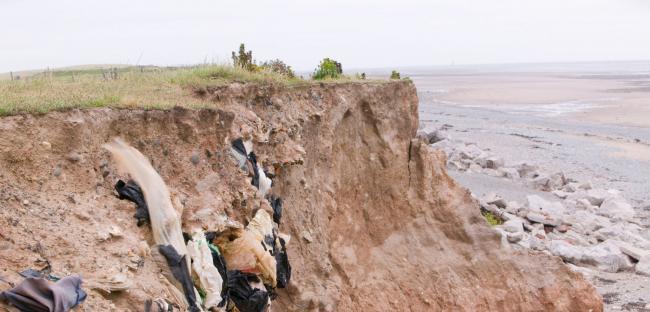Articles Menu

Dec. 15, 2021
In the early 2010s, garbage started falling out of the sand dunes in Lingreville, France. Beset by chronic coastal erosion, a long-forgotten landfill was spewing its rotten trove into the ocean. In 2016, a powerful storm dug into the site. The next year, cleanup crews stripped 14,000 cubic meters of sand mixed with waste—including asbestos—from the site. Now, researchers are warning that coastal communities around the world are set to face the same fate, with destabilized landfills on the verge of releasing large amounts of waste into the ocean.
Humans have been throwing everything from hazardous industrial waste to domestic rubbish into landfills for decades. Landfills were originally seen as eternal dumping grounds that could hold waste forever. It didn’t take long for environmental concerns to arise, and today legislation often dictates what can and can’t be chucked into a landfill. But the vast majority of landfills predate such rules. And with sea level rise causing more extreme erosion, flooding, and storm surges, we are on the verge of being reunited with much of this refuse.
Robert Nicholls, an expert in climate adaptation at the University of East Anglia in England, is concerned that people are underappreciating just how much garbage could be loosed from degrading shorelines. To demonstrate the true extent of the issue, Nicholls and his colleagues analyzed existing data on landfills in Europe and in Florida—a state set to lose huge swaths of its area over the next century—to show the vast number of historical landfills sitting precariously close to the rising ocean.
Their research shows that in France, for instance, the 1,000 municipalities located close to the coast each have at least one landfill. The Netherlands has 4,000 to 6,000 legacy landfills. With a third of the country lying below sea level, most Dutch dumps are also partly below sea level. (Though, like the rest of the country, they are hidden behind extensive flood defenses.) In Florida, the team estimates that there are 1,099 landfills at risk of flooding.
Several of these coastal tips have already started to decay. In 2008, a 400-meter-long stretch of cliff collapsed near Lyme Regis on England’s southern coast. Since then, lead, polycyclic aromatic hydrocarbons, and asbestos have all been found in the sediment nearby. Unlike in Lingreville, the cliff near Lyme Regis is too unstable to be excavated. Instead, people have been clearing the waste as it falls out. The estimated 50,000 tonnes of rubbish seems destined to erode into the ocean. That is just one of England’s roughly 1,200 historical landfills that sit within the tidal flood zone—generally near estuaries, cities, and industrial centers.
In Florida, the story is similar. The researchers found that 420 of the 1,099 landfills are at a high risk for erosion and flooding, while 592 have a moderate risk. By 2100, if sea level rise hits the higher end of projections, the number of landfills in the flood zone could almost double to 1,869.
Nicholls says that this isn’t an issue that is going to cause catastrophic problems tomorrow. Like a leaky pipe hidden in a wall, he thinks it’s more of a “drip, drip, drip problem” that will cause big issues in the long run if ignored. He says landfills need to be appraised and their management prioritized.
When it comes to dealing with problematic landfills, Nicholls says there are basically three approaches: dig them up and move them, protect them, or just let them fall into the ocean. Part of choosing which path to take hinges on understanding the nature of the waste.
“In the Victorian period, a lot of the waste is basically clinkers from coal fires,” Nicholls says. “It’s probably fairly benign domestic waste. As you move forward, it changes in nature and you get lots more plastics and things like that.”
Adam Jarvis, an environmental engineer at Newcastle University in England who was not involved with the study, agrees that risk assessments are needed. “Pragmatically, we have to do that,” he says, as we cannot realistically protect every coastal landfill from the onslaught of sea level rise. “The most important thing is to have that priority based on solid science, so there is a very clear rationale for prioritizing one site over another.”
Yet municipal trash is not the only legacy waste we need to worry about, Jarvis adds. In many coastal areas, there are also piles of waste from mining, steel and ironworks, and other industrial activities.
Indeed, the Union of Concerned Scientists warned last year that along the US east coast and Gulf of Mexico there are roughly 2,000 hazardous waste sites—commonly referred to as Superfund sites—within 40 kilometers of the ocean. At least 800 of these are at risk of extreme flooding within the next 20 years, even with low rates of sea level rise.
“The problem is probably even bigger than you would imagine,” says Jarvis.
[Top photo: Thousands of landfills built over the past century, like this one on Walney Island, England, are susceptible to flooding, sea level rise, and coastal erosion. Photo by Global Warming Images/Alamy Stock Photo]